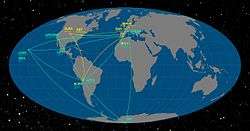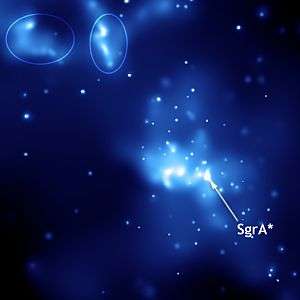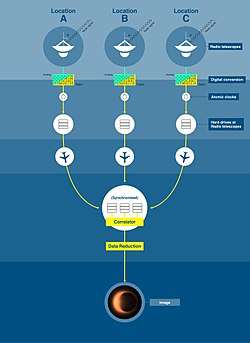Event Horizon Telescope
 | |
| Telescope style |
Project radio interferometer |
|---|---|
| Website |
www |

The Event Horizon Telescope (EHT) is a project to create a large telescope array consisting of a global network of radio telescopes and combining data from several very-long-baseline interferometry (VLBI) stations around the Earth. The aim is to observe the immediate environment of the supermassive black hole Sagittarius A* at the center of the Milky Way, as well as the even larger black hole in the supergiant elliptical galaxy Messier 87, with angular resolution comparable to the black hole's event horizon.[1][2][3][4][5]
The current director of the project is Dr. Sheperd Doeleman. The main project scientist is Dimitrios Psaltis. The current project manager is Remo Tilanus. [6]
Overview
The EHT is composed of many radio observatories or radio telescope facilities around the world to produce a high-sensitivity, high-angular-resolution telescope. Through the technique of very-long-baseline interferometry (VLBI), many independent radio antennae separated by hundreds or thousands of miles can be used in concert to create a "virtual" telescope with an effective diameter of the entire planet.[7] The effort includes development and deployment of submillimeter dual polarization receivers, highly stable frequency standards to enable very-long-baseline interferometry at 230–450 GHz, higher-bandwidth VLBI backends and recorders, as well as commissioning of new submillimeter VLBI sites.[8]
Each year since its first data capture in 2006, the EHT array has moved to add more observatories to its global network of radio telescopes. The first image of the Milky Way's supermassive black hole, Sagittarius A*, was expected to be produced in April 2017,[9][10] but due to the South Pole Telescope being closed during winter (April to October) the data shipment delayed the processing to December 2017, when the shipment arrived.[11] A date for the release of the image has not yet been announced. The image will also test Albert Einstein's general theory of relativity at the extreme.[7][10]
Data collected on hard drives must be transported by jet airliner (a so-called sneakernet) from the various telescopes to the MIT Haystack Observatory in Massachusetts, USA, and the Max Planck Institute for Radio Astronomy, Bonn, Germany, where the data are cross-correlated and analyzed on a grid computer made from about 800 CPUs all connected through a 40 Gbit/s network.[12]
Contributing institutions


Some contributing institutions are:[14]
- ALMA
- APEX
- Academia Sinica Institute of Astronomy and Astrophysics
- Arizona Radio Observatory, University of Arizona
- Caltech Submillimeter Observatory
- Combined Array for Research in Millimeter-wave Astronomy
- European Southern Observatory
- Georgia State University
- Goethe-Universität Frankfurt am Main
- Greenland Telescope
- Harvard–Smithsonian Center for Astrophysics
- Haystack Observatory, MIT
- Institut de Radio Astronomie Millimetrique
- Instituto Nacional de Astrofísica, Óptica y Electrónica (INAOE)
- East Asian Observatory – James Clerk Maxwell Telescope
- Large Millimeter Telescope
- Max Planck Institut für Radioastronomie
- National Astronomical Observatory of Japan
- National Science Foundation
- University of Massachusetts, Amherst
- Onsala Space Observatory
- Perimeter Institute
- Radio Astronomy Laboratory, UC Berkeley
- Radboud University Nijmegen
- Shanghai Astronomical Observatory (SHAO)
- Submillimeter Array (SMA)
- Universidad de Concepción
- Universidad Nacional Autónoma de México (UNAM)
- University of Chicago (South Pole Telescope)
- University of Illinois Urbana-Champaign
- University of Michigan
References
- ↑ Viewing the Shadow of the Black Hole at the Galactic Center
- ↑ Polarimetric Imaging of the Massive Black Hole at the Galactic Center
- ↑ Main project website
- ↑ Overbye, Dennis (8 June 2015). "Black Hole Hunters". NASA. Retrieved 8 June 2015.
- ↑ Overbye, Dennis; Corum, Jonathan; Drakeford, Jason (8 June 2015). "Video: Peering Into a Black Hole". New York Times. ISSN 0362-4331. Retrieved 9 June 2015.
- ↑ "Organization". Retrieved 2018-07-23.
- 1 2 O'Neill, Ian (2 July 2015). "Event Horizon Telescope Will Probe Spacetime's Mysteries". Discovery News. Retrieved 2015-08-21.
- ↑ MIT Haystack observatory
- ↑ Webb, Jonathan (8 January 2016). "Event horizon snapshot due in 2017". BBC News. Retrieved 2016-03-24.
- 1 2 Davide Castelvecchi (23 March 2017). "How to hunt for a black hole with a telescope the size of Earth". Nature. 543 (7646): 478–480. Bibcode:2017Natur.543..478C. doi:10.1038/543478a. PMID 28332538. Retrieved 30 March 2017.
- ↑ "EHT Status Update, December 15 2017". eventhorizontelescope.org. Retrieved 2018-02-09.
- ↑ Mearian, Lucas (18 August 2015). "Massive telescope array aims for black hole, gets gusher of data". Computer World. Retrieved 2015-08-21.
- ↑ "The Event Horizon Telescope and Global mm-VLBI Array on the Earth". www.eso.org. Retrieved 31 March 2017.
- ↑ Event Horizon Telescope – Collaborators Archived 2017-06-10 at the Wayback Machine.. August 2015.
Further reading
- Non-technical: The Black Hole at the Center of Our Galaxy (2001), Fulvio Melia (Princeton University Press), ISBN 0691095051
- Technical: The Galactic Supermassive Black Hole (2008), Fulvio Melia (Princeton University Press), ASIN B008VQXCN2
External links
- Official website
- Peering into a Black Hole, New York Times video 2015